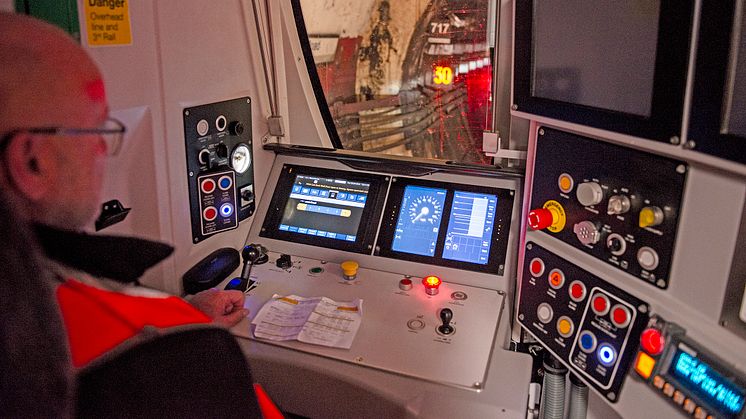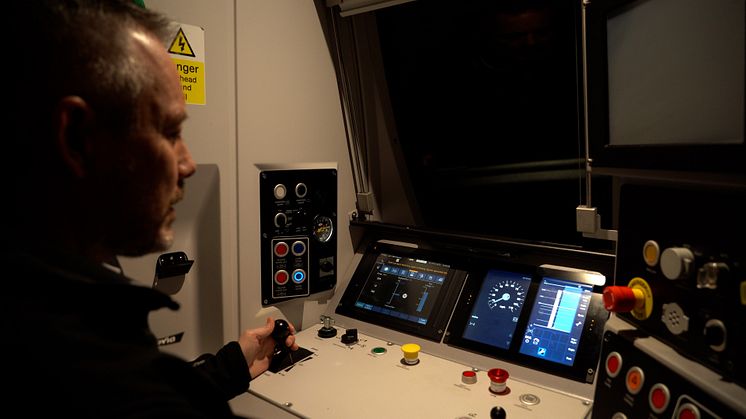
Press release -
Half of all commuter trips now digitally signalled on rail route to City of London
More than half the trains Great Northern commuters take to Moorgate in the City of London are now controlled using ground-breaking digital signalling.
The European Train Control System (ETCS) does away with the need for signals at the side of the track. Instead, drivers are continually fed a safe target speed to aim for on a computer screen in their cab. This allows trains to run closer together and enables a more consistent and reliable service for passengers.
The first passenger train ran to the City of London using digital signalling technology in November 2023. Since then, Govia Thameslink Railway (GTR) has been steadily training more of its Great Northern drivers to use the system.
Now, just over half of all journeys on the Northern City Line, between Finsbury Park and Moorgate, run in ETCS. This number is set to steadily increase as more Great Northern drivers are trained in the new technology, and journeys will become more reliable.
Oliver Turner, head of digital signalling (Head of ERTMS) at GTR, said: “We are delighted that our Great Northern commuters can now expect at least every other train to be digitally signalled.
“It represents a significant step towards a digital future in which technology will improve customer journeys on both the Northern City Line and, eventually, the East Coast Main Line. We are proud to share our knowledge and experience gained here with the rest of the rail industry.”
Introducing digital signalling on this busy commuter line is an important first step towards replacing regular signals with in-cab digital signalling on the southern part of the East Coast Mainline, between King’s Cross and Grantham. The first train ran using the system on a section of this mainline under test conditions two weeks ago (see press release UK-first sees digitally signalled train driven on intercity mainline).
It’s all part of the East Coast Digital Programme, which will see the first introduction of digital ETCS to an intercity mainline in Great Britain and provide the foundation for the future expansion of digital signalling across the UK rail network.
ENDS
Notes to Editors
- The Northern City Line is the first phase of the East Coast Digital Programme, which will see the first introduction of the digital European Train Control System (ETCS) to an intercity mainline in Great Britain, and will provide the foundation for the future expansion of digital signalling across the network.
- Installation of ETCS on the Northern City Line has been in development since 2020, and has, until now, been tested only on trains out of passenger hours.
- In-cab signalling provided by ETCS Level 2 operation supplies continual speed information and movement authority to the driver via a computer screen in the driver’s cab, rather than relying on fixed lineside signals.
- Traditional signals will be kept at the side of the track on the Northern City Line until all 250 Great Northern drivers are trained and the old system can be switched off. Having the two systems working side-by-side during the training programme means trained drivers will be able to continue using digital ETCS alongside their untrained colleagues once they are qualified, ensuring they maintain their competency.
- Digital signalling contributes to a greener railway. The East Coast Main Line is already electrified, and these upgrades will deliver a further 55,000 tonne reduction in carbon emissions over 60 years – the equivalent to over 65,000 one-way flights from London to New York, or over 2 million passenger train journeys from London to Edinburgh. This is because there is much less physical equipment to produce and maintain compared with what’s needed for ‘traffic light’ signals. The estimated whole life carbon saving over a 60-year period (the expected life span of a ‘traditional’ signalling system) is around 39%. The technology also allows gentler braking, meaning journeys are smoother and use less energy. Finally, a more reliable and punctual railway will encourage more people to choose rail over road and air, ultimately reducing transport emissions for the long-term.
- Since the system was introduced and aging equipment on the Northern City Line replaced, dating back to 2022, delays as a result of signalling-related infrastructure faults have significantly reduced.
Topics
Categories
For more information, contact the press office on 0203 750 2031.
Govia Thameslink Railway
Govia Thameslink Railway (GTR) operates Thameslink, Great Northern, Southern and Gatwick Express services as follows:
- Thameslink – cross-London services between Bedford/Peterborough/Cambridge and Brighton/Horsham/East Grinstead, and between Luton/St Albans and Sutton/Wimbledon/Rainham; plus services between London and Sevenoaks
- Great Northern – services between London and Welwyn, Hertford, Peterborough, Cambridge and King’s Lynn
- Southern – services between London and the Sussex coast (Brighton, Worthing, Eastbourne, Bognor Regis, Hastings) and parts of Surrey, Kent and Hampshire (Ashford International, Southampton, Portsmouth)
- Gatwick Express – fast, non-stop direct services between Gatwick Airport and London Victoria
www.southernrailway.com, www.thameslinkrailway.com, www.gatwickexpress.com, www.greatnorthernrail.com



